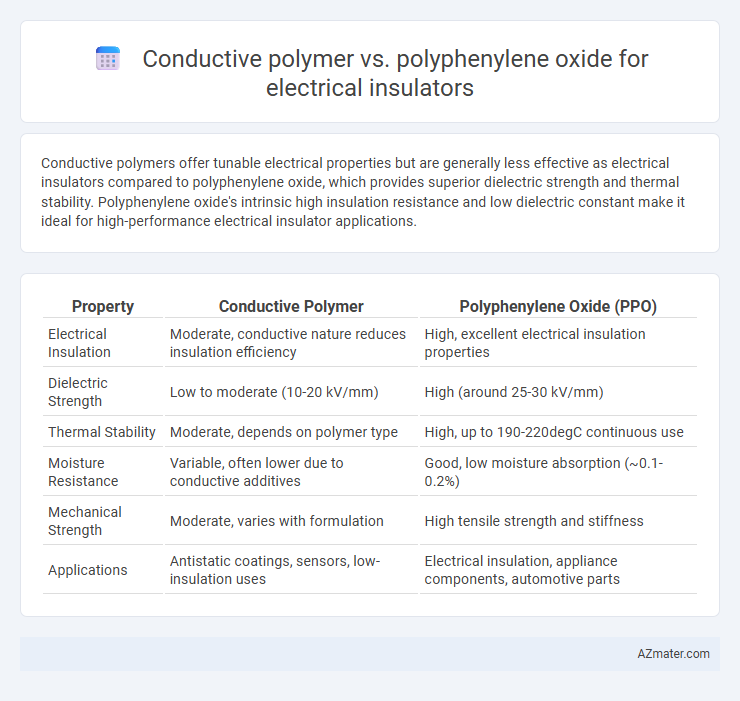Conductive polymers offer tunable electrical properties but are generally less effective as electrical insulators compared to polyphenylene oxide, which provides superior dielectric strength and thermal stability. Polyphenylene oxide's intrinsic high insulation resistance and low dielectric constant make it ideal for high-performance electrical insulator applications.
Table of Comparison
| Property | Conductive Polymer | Polyphenylene Oxide (PPO) |
|---|---|---|
| Electrical Insulation | Moderate, conductive nature reduces insulation efficiency | High, excellent electrical insulation properties |
| Dielectric Strength | Low to moderate (10-20 kV/mm) | High (around 25-30 kV/mm) |
| Thermal Stability | Moderate, depends on polymer type | High, up to 190-220degC continuous use |
| Moisture Resistance | Variable, often lower due to conductive additives | Good, low moisture absorption (~0.1-0.2%) |
| Mechanical Strength | Moderate, varies with formulation | High tensile strength and stiffness |
| Applications | Antistatic coatings, sensors, low-insulation uses | Electrical insulation, appliance components, automotive parts |
Introduction to Electrical Insulators
Electrical insulators like polyphenylene oxide (PPO) provide high dielectric strength and thermal stability, making them essential for preventing unwanted current flow in electronic devices. Conductive polymers, in contrast, are engineered to exhibit controlled electrical conductivity while maintaining some insulating properties, suitable for specialized applications such as antistatic coatings or flexible electronics. PPO remains the preferred choice for traditional electrical insulation due to its superior mechanical strength and resistance to heat and moisture.
Overview of Conductive Polymers
Conductive polymers exhibit unique electrical properties due to their conjugated double bond structures, enabling controlled conductivity while maintaining polymer flexibility and lightweight characteristics. Unlike traditional insulating materials such as polyphenylene oxide, which offer excellent thermal stability and dielectric strength, conductive polymers are engineered to balance conductivity and insulation for specialized electronic applications. These materials find critical use in sensors, antistatic coatings, and flexible electronics, where their tunable conductivity and mechanical resilience outperform conventional electrical insulators.
Understanding Polyphenylene Oxide (PPO)
Polyphenylene oxide (PPO) exhibits excellent electrical insulation properties due to its high dielectric strength and thermal stability, making it a preferred material for insulating components in electronic devices. Unlike conductive polymers, which are designed to conduct electricity, PPO maintains robust electrical resistance and low dielectric constant, ensuring reliable insulation performance under high-voltage conditions. Its chemical resistance and mechanical durability further enhance its suitability for applications requiring long-lasting electrical insulation.
Electrical Properties: Conductive Polymers vs Polyphenylene Oxide
Conductive polymers exhibit variable electrical conductivity, ranging from semiconducting to metallic levels, enabling applications in antistatic coatings and flexible electronics, while polyphenylene oxide (PPO) offers high dielectric strength and excellent insulating properties crucial for reliable electrical insulation. PPO's stable electrical resistance and low dielectric loss make it ideal for high-frequency insulator applications, whereas conductive polymers often serve roles where controlled conductivity and charge transport are required. The choice between conductive polymers and PPO depends on the desired balance between conductivity and insulation, with PPO favored in high-performance electrical insulators and conductive polymers suited for electroactive components.
Dielectric Strength Comparison
Conductive polymers typically exhibit lower dielectric strength compared to polyphenylene oxide (PPO), which is known for its high electrical insulation properties and dielectric strength often exceeding 20 kV/mm. PPO's rigid molecular structure and high glass transition temperature contribute to its superior ability to withstand high electric fields without breakdown. In contrast, conductive polymers, designed for electrical conductivity, generally have compromised dielectric properties, making PPO a more suitable choice for applications requiring robust electrical insulation.
Thermal Stability and Performance
Conductive polymers generally exhibit lower thermal stability compared to polyphenylene oxide (PPO), which maintains structural integrity and consistent electrical insulation properties at temperatures up to 260degC. PPO's superior thermal performance makes it a preferred choice for high-temperature electrical insulation applications, offering enhanced dimensional stability and resistance to thermal degradation. In contrast, conductive polymers may degrade more rapidly under elevated temperatures, limiting their effectiveness in demanding electrical insulator environments.
Mechanical Properties and Durability
Conductive polymers typically exhibit lower mechanical strength and durability compared to polyphenylene oxide (PPO), which offers excellent rigidity and thermal stability critical for electrical insulators. PPO maintains dimensional stability and resistance to environmental degradation, ensuring long-term insulation performance under mechanical stress and thermal cycles. The inherent brittleness of many conductive polymers limits their application in high-stress environments where PPO's superior tensile strength and impact resistance provide significant advantages.
Processing and Fabrication Methods
Conductive polymers are typically processed through solution casting, spin coating, or electrochemical polymerization, allowing precise control over film thickness and conductivity, whereas polyphenylene oxide (PPO) is commonly fabricated via injection molding or extrusion, offering excellent thermal stability and mechanical strength for electrical insulators. Conductive polymers require careful doping to achieve desired electrical properties, often limiting their thermal processing window, while PPO's thermoplastic nature provides easier fabrication with superior dimensional stability. The choice between these materials depends on the balance between electrical performance and manufacturing scalability within insulating applications.
Environmental Resistance and Longevity
Conductive polymers typically exhibit moderate environmental resistance with potential degradation under prolonged UV exposure and moisture, whereas polyphenylene oxide (PPO) offers superior resistance to heat, chemicals, and weathering, making it ideal for long-term electrical insulation. PPO's inherent thermal stability and dimensional integrity contribute to extended service life in harsh environments compared to many conductive polymers. This makes PPO a preferred choice for applications requiring durable electrical insulators with enhanced longevity and minimal performance loss.
Application Suitability: Choosing the Right Insulator
Conductive polymers and polyphenylene oxide (PPO) differ significantly in electrical insulation applications due to their intrinsic material properties. Conductive polymers, known for their tunable electrical conductivity, are more suitable for antistatic coatings and flexible electronics where partial conductivity is required, whereas PPO offers excellent thermal stability, dimensional stability, and high dielectric strength, making it ideal for high-performance electrical insulators in automotive and aerospace components. Selecting the right insulator depends on the specific application's requirements for conductivity, thermal resistance, and mechanical durability.

Infographic: Conductive polymer vs Polyphenylene oxide for Electrical insulator
 azmater.com
azmater.com